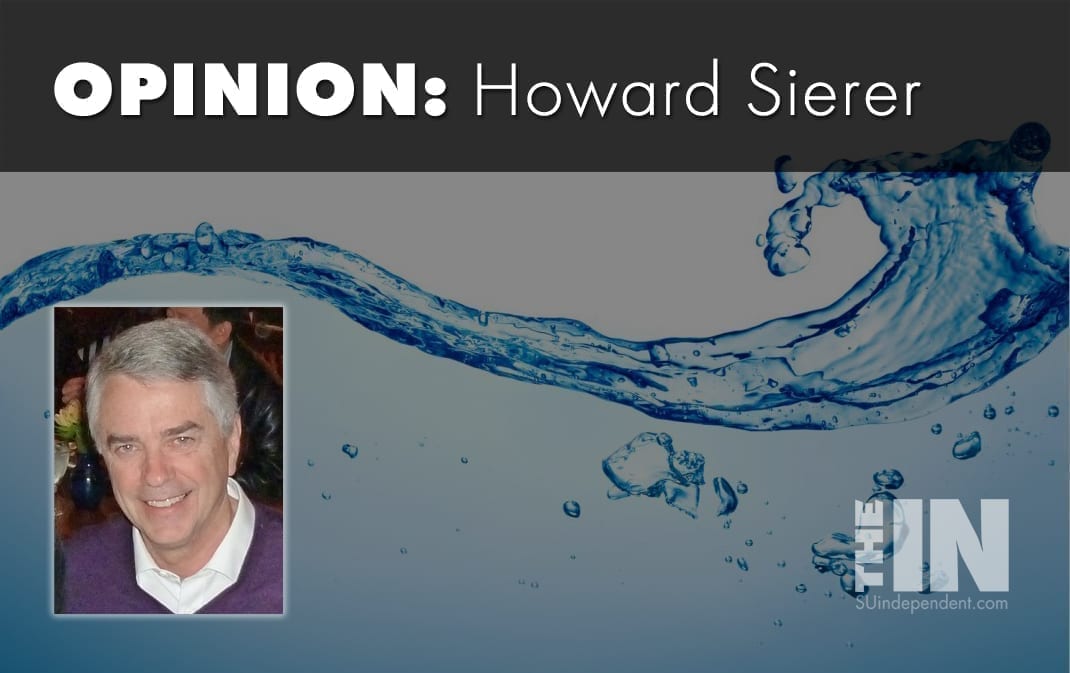
New St. George Water Rates: A Baby Step Toward Conservation
Talk is cheap. Case in point: All the talk we hear about conserving water in Southern Utah.
Water is cheap in Southern Utah. That’s why we use – and misuse – way too much of it.
We live in the desert, but we don’t act like it. Per our Washington County Water Conservancy District, St. George uses 302 gallons per capita per day when reuse water is included, compared to regional leader Tucson with a similar climate and economy that uses only 122 GPCD.
Water conservation is stressed all across the southwestern U.S. with our Conservancy District budgeting $450,000 on the effort this year. So why the great disparity in water use? In a word: cost. Water rates are low here, lower than Las Vegas, Albuquerque, and Grand Junction, CO.
We hear how those living here many decades ago sacrificed to access available water, primarily the Virgin River and its tributaries, how they constructed the dams and reservoirs that collect this water. We all benefit today from those sacrifices made long ago.
But an unappreciated result of that legacy is low-cost water, tapping a river running right through our midst. The Washington County Water Conservancy District continues to make comparatively modest additions to our water collection, storage, and processing capacity whose costs are readily spread across the growing population, keeping costs low.
But our ability to wring more water out of the Virgin River basin is coming to an end in the foreseeable future, leaving us with two choices. On the one hand, we’re being urged to support a multi-billion-dollar Lake Powell pipeline, paid for by significant increases in water rates. Or we can put some teeth into conservation efforts by incrementally raising water rates for heavy water users.
The St. George Water Department presented data to the city council showing that about 80 percent of its residential customers use an average of 11,000 gallons of water per month. Those customers in the top 20 percent or so, average over 25,000 gallons per month.
The St. George City Council took a baby step earlier this year toward encouraging heavy water users to conserve by raising their water rates. It’s about time.
I call this increase a baby step because I compare it to Tucson’s water rates, the gold standard in the desert southwest. The following table compares St. George’s prior and new water rates with Tucson’s:
| Mo. Usage | Prior St. George | New St. George | Tucson |
| 7500 gal. | $28.17 | $28.25 | $38.85 |
| 15,000 gal. | $35.67 | $39.50 | $79.57 |
| 22,500 gal. | $47.97 | $53.00 | $142.93 |
| 30,000 gal. | $60.97 | $68.75 | $221.04 |
| 37,500 gal. | $75.72 | $87.87 | $307.73 |
| 45,000 gal. | $91.57 | $110.37 | $417.18 |
| 60,000 gal. | $125.47 | $163.62 | $623.13 |
St. George’s new rates are somewhat more progressive than its prior rates. Those in the lower 80 percent will see only modest increases if any, primarily in summer months. But comparing St. George’s new rates to Tucson’s rates is an eye-opener and explains why Tucson’s water use per capita is well less than half of St. George’s.
St. George water users in the upper 20 percent, those with large lawns, swimming pools, and water features are those who are taking advantage of our legacy of cheap Virgin River water. As Southern Utah grows and new homes are built, water use is not nearly the cost factor for builders and buyers that it is in Tucson or other cities in the southwest.
For example, Austin, Texas, raised its rates dramatically for high volume users in 2011 and was using 20 percent less water in total by 2014. We could expect similar results in St. George.
For existing homeowners, even St. George’s baby step water rate increase should be a wake-up call, especially now that the Water Conservancy District has put us on notice that its underlying rates will be increased by 10 cents per 1000 gallons each year for the next ten.
Now is the time to consider removing some or all of large lawns or water features, replacing them with smaller lawns and xeriscaping. After all, Southern Utah is not Salt Lake South: we live on the eastern edge of the Mojave Desert!
Conservation, encouraged by higher water rates, is far more prudent than leaving the Lake Powell pipeline as a legacy to our children to pay for the rest of their lives. The pipeline is an all-or-nothing proposition: it can’t be built in stages. In contrast, experimenting with conservation can be done incrementally and still leaves individuals free to make water-use choices that suit their circumstances.
Ironically, building the pipeline could render it unneeded. Twenty Utah economists estimated that water rate increases of as much as 678 percent (Tucson, here we come!) would be required to pay for the pipeline. Even a 100 percent increase would encourage massive water conservation, likely enough so that no pipeline water would be needed. But we’d still be paying for an unused relic.
St. George’s water rate increase is long overdue. Almost all of our elected leaders want to encourage future population growth. Before they lock us into massive pipeline debt, I urge them to look first to the only sure way to practice the water conservation they preach: higher water rates for higher volume users.
Viewpoints and perspectives expressed throughout The Independent are those of the individual contributors. They do not necessarily reflect those held by the staff of The Independent or our advertising sponsors. Your comments, rebuttals, and contributions are welcome in accordance with our Terms of Service. Please be respectful and abide by our Community Rules. If you have privacy concerns you can view our Privacy Policy here. Thank you!
Click here to submit an article, guest opinion piece, or a Letter to the Editor





Thanks for this great op-ed, Howard. People who have chosen to live in Washington County such as I and many others should accept the fact that with the decision to live in the desert comes a responsibility to “act” like we live in the desert. Yes, the weather here (except for mid-summer!) is great but we can’t have everything. Do what’s needed to make our water supply last, which it can if managed wisely. Also, I would encourage people to remember that although the district and other officials like to keep the focus on that little ribbon of water we call the Virgin River in their effort to stress the fragility of our water supply, the Kanab Creek/Virgin River Basin is actually quite large, and the Navajo aquifer that is under much of Washington County also provides water through a series of wells. Additionally, there is a good size aquifer under Sand Hollow that currently holds about 140,000 acre-feet of water and will ultimately hold around 300,000 acre-feet, at lease that’s what the water district tells Fitch, the bonding agency that helps keep our county’s bond rating at AAA. Thanks again, Howard!
I hate it when you hit one out of the park, Howard. This column was well documented, well stated and spot on. Excellent! Should be required reading.
I might agree with you except for my personal experience.
We moved here in 2007. I acted like I live in a desert. I removed my sod. Water usage went way down. I still have no sod. We only have two people in the house. These baby steps that have increased my cost of water appear to be related to the increase of infrastructure for all of the new housing and the mythical pipeline. Why is it that our rates should increase to help the developers make a profit? Why would we not increase the assessment on new development so that those profiting form the development are paying for that development from which they will profit. Since we are being told to pay more, will they refund and of their profit?
Thanks for your thoughtful comment.
Your situation is much like ours: we removed sod, use drip irrigation on our xeriscape yard, and have just two of us at home. But all households seem to use water differently. You might check your St. George utility bill to see how many gallons of water you’ve been using each month, then compare your water charges to the table in my column above.
Please note that my column calls for dramatically increased rates for high volume users only while lower volume users would see little change.
As for developers and new houses, the Water District’s response would be that it already charges developers a substantial upfront fee for each new water tap, a fee that developers pass to the buyer. Folks like you and me are likely to believe that the District’s fee must not be high enough, that all costs associated with providing new service, should be covered by the developer’s water tap fee. I’m sure the district would respond that determining how to allocate costs is complicated and I’m sure it is. But why shouldn’t new users and only new users pay the entire cost of the pipeline? That would halt the pipeline in its tracks.